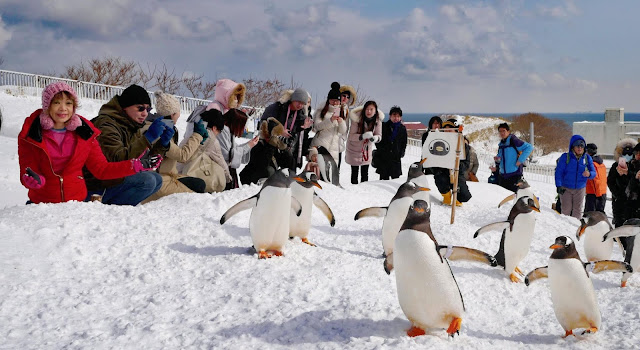

Imagine a very cold place where temperatures dip way below zero degrees Celcius for weeks on end, with plenty of snow and ice. One can either struggle to keep warm and stay alive or ... create a whole tourist industry around a snow festival!
This started in 1950, when a group of local highschool students decided to carve a modest public display of 6 sculptures in Odori Park, which attracted 50,000 visitors. Over the years, the festival became famous & now gets 2 million visitors every year!
In 1987, Theresa and I escaped our steamy tropical island on a group tour to Hokkaido during the Snow Festival (Above left, is a snapshot of Theresa next to King Kong). In 2018, Sapporo celebrated its 69th edition and Theresa can be seen at right, pitching in with the locals!
This started in 1950, when a group of local highschool students decided to carve a modest public display of 6 sculptures in Odori Park, which attracted 50,000 visitors. Over the years, the festival became famous & now gets 2 million visitors every year!
In 1987, Theresa and I escaped our steamy tropical island on a group tour to Hokkaido during the Snow Festival (Above left, is a snapshot of Theresa next to King Kong). In 2018, Sapporo celebrated its 69th edition and Theresa can be seen at right, pitching in with the locals!

This time, we decided to cobble our own itinerary, having already worked out the super-efficient Japan Rail (JR) transport system. Amazingly, these public transport trains still manage to run like clockwork in whichever season and changeable weather! Staying at hotels within 5 to 10 minutes' walking distance from the mainstreet JR stations made good sense, especially as the festival organisers organised most happenings right in the heart of town. For Sapporo, the central Odori Park was transformed into a magical winter wonderland, with Sapporo Tower's commanding overview of the Park.
In the intervening years, sister cities like Asahikawa and Otaru in Hokkaido, have also cottoned on to the idea. Thus, our trip this time round was far more interesting, with time spent experiencing their different interpretations. The "Snow Light Path" in Otaru was much more intimate and romantic while Asahikawa's ceremonies were on a grander scale, on account that their venue sprawled over a much bigger riverside esplanade. We shall elaborate more on these other celebrations in the next few blog postings...



























